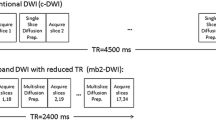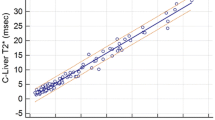Abstract
Purpose:
Hepatic pseudo-anisotropy is an artifact observed in hepatic diffusion-weighted imaging under respiratory triggering (RT-DWI). To determine the clinical significance of this phenomenon, hepatic RT-DW images were reviewed.
Methods:
One hundred and five MR examinations, including RT-DWI, were assessed. The patient group included 62 non-cirrhotic and 43 cirrhotic individuals. All images were evaluated by mutual agreement of two radiologists from the viewpoints of incidence of pseudo-anisotropy and correlation between pseudo-anisotropy and the quality of trace images. The ADC of normal hepatic parenchyma of non-cirrhotic livers were measured in both areas with and without pseudo-anisotropy.
Results:
Pseudo-anisotropy was observed in 60% of non-cirrhotic (37/62) and 30% of cirrhotic (13/43) images. The difference between the two groups was statistically significant (P < 0.001). The quality of trace images showed a tendency to worsen as pseudo-anisotropy became significant. However, the quality of trace images was generally satisfactory, with only two patients whose trace images were difficult to interpret due to pseudo-anisotropy. The areas with pseudo-anisotropy showed higher ADC than those without pseudo-anisotropy (P < 0.001).
Conclusion:
Pseudo-anisotropy is a type of artifact that originates from respiratory movement. Even though respiratory triggering is employed, ADC measurement of the liver is inaccurate because of pseudo-anisotropy, especially in non-cirrhotic patients.
Similar content being viewed by others
References
Rovira A, Rovira-Gols A, Pedraza S, Grive E, Molina C and Alvarez-Sobin J (2002). Diffusion-weighted MR imaging in the acute phase of transient ischemic attacks. AJNR 23: 77–83
Basser PJ, Pajevic S, Pierpaoli C, Duda J and Aldroubi A (2000). In vivo fiber tractgraphy using DT–MRI data. Magn Reson Med 44: 625–632
Sugahara T, Korogi Y, Kochi M, Ikushima I, Shigematu Y, Hirai T, Okuda T, Liang L, Ge Y, Komahara Y, Ushio Y and Takahashi M (1999). Usefulness of diffusion-weighted MRI with echo-planar technique in the evaluation of cellularity in gliomas. JMRI 9: 53–60
Pruessmann KP, Weiger M, Scheidegger MB and Boesiger P (1999). SENSE: sensitivity encoding for fast MRI. Magn Reson Med 42: 952–962
Bammer R, Keeling SL, Augustin M, Pruessmann KP, Wolf R, Stollberger R, Hartung HP and Fazekas F (2001). Improved diffusion-weighed single-shot echo-planar imaging (EPI) in stroke using sensitivity encoding (SENSE). Magn Reson Med 46: 548–554
Nasu K, Kuroki Y, Kuroki S, Murakami K, Nawano S and Moriyama N (2004). Diffusion-weighted single shot echo planar imaging of colorectal cancer using a sensitivity-encoding technique. JJCO 34: 620–626
Kuroki Y, Nasu K, Kuroki K, Murakami K, Hayashi T, Sekiguchi R and Nawano S (2004). Diffusion weighted imaging of breast cancer with the apparent diffusion coefficient value. Magn Reson Med Sci 3: 79–85
Nasu K, Kuroki Y, Nawano S, Kuroki S, Tsukamoto T, Yamamoto S, Motoori K and Ueda T (2006). Hepatic metastases: diffusion-weighted sensitivity-encoding versus spio-enhanced mr imaging. Radiology 239: 122–130
Stejskal EO and Tanner JE (1965). Spin echoes in the presence of a time-dependent field gradient. J Chem Phys 42: 288–292
Nasu K, Kuroki Y, Sekiguchi R and Nawano S (2006). The effect of simultaneous use of respiratory triggering in diffusion weighted imaging of the liver. MRMS 5: 129–136
Murz P, Flacke S, Traber F, van den Brink JS, Gieseke J and Schild HH (2002). Abdomen: diffusion-weighted MR imaging with pulse-triggered single-shot sequence. Radiology 224: 258–264
Nasu K, Kuroki Y, Sekiguchi R, Kazama T and Nakajima H (2006). Measurement of the apparent diffusion coefficient in the liver: is it a reliable index for hepatic disease diagnosis. Radiat Med 24: 438–444
**ng D, Papadekin NG, Haung CLH, Lee VM, Carpenter TA and Hall LD (1997). Optimized diffusion-weighting for measurement of apparent diffusion coefficient in human brain. Magn Reson Imaging 15: 771–784
Wang J, Takayama F, Kawakami S, Saito A, Matsushita T, Momose M and Ishiyama T (2001). Head and neck lesions: characterization with diffusion-weighted echo-planar MR imaging. Radiology 220: 621–630
Guo AC, Dash RC and Provenzale JM (2002). Lymphomas and high-grade astrocytomas: comparison of water diffusibility and histologic characteristics. Radiology 224: 177–183
Beneviste H, Hedlund L and Jonson G (1992). Mechanism of detection of acute cerebral ischemia in rats by diffusion-weighted magnetic resonance microscopy. Stroke 23: 746–754
Takahara T, Imai Y, Yamashita T, Yasuda S, Nasu S and van Cauteren M (2004). Diffusion weighted whole body imaging with background body signal suppression (DWIBS): technical improvement using free breathing, STIR and high resolution 3D display. Radiat Med 22: 275–282
Le Bihan D, Poupon C, Amadon A and Lethimonnier F (2006). Artifacts and pitfalls in diffusion DWI. JMRI 24: 467–488
Bernstein MA, King KF, Zhou XJ (2004) Handbook of pulse sequence. Advanced pulse sequence technique, Chap 17. Elsevier, SanDiego, pp 802–896
Rohlifing T, Maurer CR Jr, O’Dell WG and Zhong J (2004). Modeling liver motion and deformation during the respiratory cycle using intensity-based nonrigid registration of gated MR images. Med Phys 31: 427–432
Dienes JK (1979). On the analysis of rotation and stress rate in deforming bodies. Acta Mech 32: 217–232
Bentrem DJ, Dematteo RP and Blumgart LH (2005). Surgical therapy for metastatic disease to the liver. Annu Rev Med 56: 139–156
Author information
Authors and Affiliations
Corresponding author
Rights and permissions
About this article
Cite this article
Nasu, K., Kuroki, Y., Fujii, H. et al. Hepatic pseudo-anisotropy: a specific artifact in hepatic diffusion-weighted images obtained with respiratory triggering. Magn Reson Mater Phy 20, 205–211 (2007). https://doi.org/10.1007/s10334-007-0084-0
Received:
Revised:
Accepted:
Published:
Issue Date:
DOI: https://doi.org/10.1007/s10334-007-0084-0




